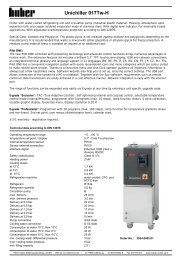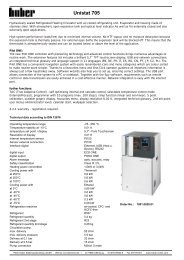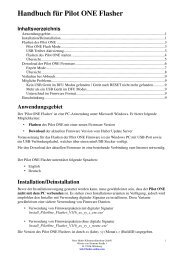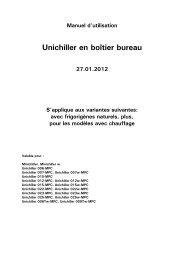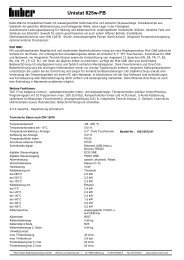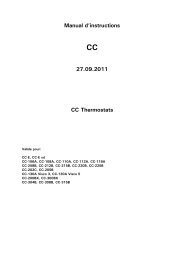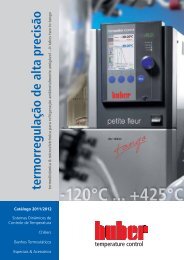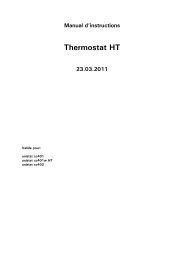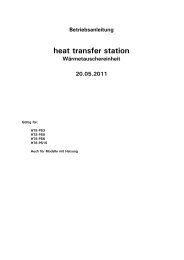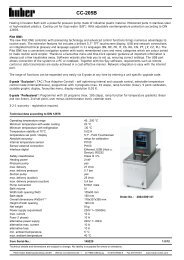Operating manual 27.09.2011 CC Heating Thermostats - HUBER
Operating manual 27.09.2011 CC Heating Thermostats - HUBER
Operating manual 27.09.2011 CC Heating Thermostats - HUBER
You also want an ePaper? Increase the reach of your titles
YUMPU automatically turns print PDFs into web optimized ePapers that Google loves.
To 1. Temperature control machines with classcial float<br />
The most common and known type of level monitoring is the mechanical float. The float<br />
swims on the surface of the thermal fluid in the bath, and leads to a switching system.<br />
Depending on the level of the thermal fluid, the electronics will either signalize an OK<br />
state (with sufficient filling of the thermal fluid) or a non OK state (with insufficient<br />
filling of the thermal fluid). The float system function should be checked from time to<br />
time. In order to do this, whilst in standby mode, push the float in the bath downwards<br />
with a tool (e.g. screw driver). The electronics should then trigger an alarm.<br />
To 2. Temperature control machines with electronical low-level protection (ELO)<br />
ELO: Electronic over-temperature and low-level protection in combination<br />
Some temperature control machines (depending on the model) possess an electronic<br />
over-temperature and low-level protection. Instead of a mechanical float switch<br />
temperature sensors are mounted on the surface of the heating coils to monitor the<br />
over-temperature at a potential ignition source and to ensure that the critical<br />
temperature at the heating coils (burn point of the thermal fluid) is controlled by the<br />
controller (not valid for chillers, liquid level is determined by electrical capacity) via the<br />
graphical display (60) error message will be given out.<br />
A mechanical tool is no longer required to change the over-temperature settings. The<br />
over-temperature switch can only be adjusted after the user has re-entered a code<br />
displayed on the <strong>CC</strong>-Pilot´s display (60). This procedure avoids unintentional changes<br />
being made to the setting and replaces a mechanical tool by software.<br />
A new feature is the Process Safety function. This function provides further protection<br />
for the operators and application. A classic over-temperature device unit would trip and<br />
cause a shutdown if over-temperature cut-off temperature was reached. This could<br />
occur under circumstances where more heat was being generated by a process<br />
(exothermic) than the unit could remove. Switching the temperature control unit off<br />
would remove the only possible method of cooling the application down. Consequently,<br />
the temperature would be able to further increase, creating a risk of injury to personnel<br />
or damage to the application, for example by over-heating a liquid into pressurised<br />
vapour.<br />
Using the Process Safety function, the controller recognises when the over-temperature<br />
cut-off is reached, and switches the cooling on. The compressor automatic is<br />
automatically set to always on. Even if the temperature continues to rise, the<br />
refrigeration machine will increase its cooling to maximum to minimise the heating.<br />
Please also note chapter on Setting the over-temperature (OT) switch.<br />
13



